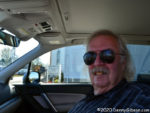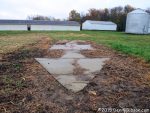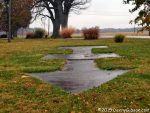 Like many, I’ve thought of writing a memoir. Maybe I already have. Considering that “a memoir is a form of creative nonfiction in which an author recounts experiences from his or her life”, each of the travelogues I’ve published might qualify. But it’s when I remember other, not necessarily travel-related, experiences from my life that the word memoir enters my head. That happened today. I’m reading Down the Great Unknown about John Wesley Powell’s pioneering trip down the Green and Colorado Rivers and just finished a section discussing the sensations of traveling through whitewater. It naturally made me recall some of my own whitewater experiences. There aren’t all that many, but there are a couple I’ve thought of writing down in the past. The dearth of new subject matter resulting from the current coronavirus quasi-quarantine combined with today’s memories prompted me to begin a series of “memoir posts” and kick it off with this rafting story.
Like many, I’ve thought of writing a memoir. Maybe I already have. Considering that “a memoir is a form of creative nonfiction in which an author recounts experiences from his or her life”, each of the travelogues I’ve published might qualify. But it’s when I remember other, not necessarily travel-related, experiences from my life that the word memoir enters my head. That happened today. I’m reading Down the Great Unknown about John Wesley Powell’s pioneering trip down the Green and Colorado Rivers and just finished a section discussing the sensations of traveling through whitewater. It naturally made me recall some of my own whitewater experiences. There aren’t all that many, but there are a couple I’ve thought of writing down in the past. The dearth of new subject matter resulting from the current coronavirus quasi-quarantine combined with today’s memories prompted me to begin a series of “memoir posts” and kick it off with this rafting story.
I was never an expert but at one point in my life I did a fair amount of canoeing and a little rafting. I believe there were a total of four rafting trips on either the New or Gualey Rivers in West Virginia. This story is from the first or second of those outings. Part of me really thinks it was the second trip but I can’t be certain. The time was around 1980. A neighbor joined three coworkers and me and headed off for a little camping and floating.
The rafts used held eight “passengers” and a guide. Two were enough to hold everyone who had reserved a spot but not enough the keep the three groups intact. The other two groups were families who really wanted to stay together and our group was just some guys on a lark. Three of us went with one family and my neighbor and I went with the other. Mom, dad, and three young teenagers made up the family in our raft.
The style of raft we were using has deck strapped to the rear for the guide and a pair of long oars. Everyone else sits on the big tubes that make up the frame of the raft. In addition to those that form the perimeter of the raft, a couple run from side to side sort of functioning as benches. That’s not us in the opening picture but it does show the type of raft we used. I earlier put the word passengers in quotes since anyone not on those benches holds a paddle and is expected to use it in certain situations. It was apparent almost immediately that the teens weren’t going to be a lot of help in this regard although the oldest was quite willing. Mom didn’t really want anything to do with a paddle so the “crew” became Larry (the neighbor), Dad, Son #1, and me. Larry and I, both in our thirties, manned the two front corners. Dad and Son #1 took the two rearmost positions and Mom positioned herself on a bench. I think the two other kids flitted between bench and side tube.
We were on the milder section of the New with no rapid above Class III. We came to our first Class II after easily floating through a couple of Class Is as expected. Rubber rafts are quite flexible and often bend and unbend so that riders get something of a bucking horse sensation. That’s what happened at that Class II and it was pretty exhilarating. At least it was for most of us. When Larry and I turned around to express our approval to the guide, he wasn’t there. Neither was Dad. Mom’s already challenged composure wasn’t far behind.
We learned later what happened. When the raft bent and straightened, Dad lost his grip and was thrown backward over the guide. The guide made a quick decision that it was better for him to accompany the man exiting the raft rather than stay with the relatively safe folks in it. He grabbed at Dad as he tumbled by and hit the water with him. Larry and I looked over the astonished teens and the now screaming Mom and then at each other. Neither of us had any experience with a raft but I had the most canoe time so I headed to the back and took up the oars. It was neither quick nor pretty but I did eventually get the raft turned around and reached the guide and Dad. Both were laughing and it was obvious that Dad had quite enjoyed the tumble and swim.
His wife did not share his joy. She basically crumpled to the floor of the raft. River rapids are filled with rocks that rubber rafts slide over. When that happens, the floor is not a place one should be. For the rest of the trip, each time we approached something shallow, the kids would somehow talk Mom into sitting on a bench but she returned to the floor as soon as they allowed.
There were some bigger rapids and it’s the memory of these that reading about Powell’s trip first triggered. The book spoke of the instant when you are poised at the edge of a significant rapid with the water seeming to tower above you. It’s a sensation I remember vividly and which author Edward Dolnick describes well.
Between the loss and recovery of Dad and our guide and the final rapid, things were uneventful. Dad and the kids had talked about his unplanned swim and as we approached the day’s last rapid, the guide offered them a chance to experience it themselves. The rapid was a mild one, he said, with few rocks. Any who wanted to float through in lifejackets were welcome to do so. I’d kind of enjoyed the new experience of maneuvering the raft with those big oars and took this as an opening. If the rapid was that mild, I wondered, would he let me take the raft through? He agreed and jumped overboard himself.
Dad and the kids also bailed out leaving just me, Mom, and Larry onboard. The power of those big oars compared to a wimpy canoe paddle is impressive. Positioning the raft at the top of the rapid was rather easy and after that, there wasn’t much to do. The raft and several floating bodies slid into some ripples. Suddenly there was screaming at the side of the raft. It was one of the teens and I thought I must have hit her with an oar. That was the scariest moment of the whole trip for me but it turned out to be almost nothing. She had gone underwater and somehow came up under the raft. Finding the surface blocked by a big black sheet is undoubtedly frightening and that’s what prompted the screams as she slid to the side and up to the surface.
Back in quiet water, everyone climbed back on board and the guide steered us to our pull out point. As we waited for the bus back to the livery, I approached Dad to apologize for scaring his daughter and for his wife’s obviously bad time. He wasn’t having it at all. He was ecstatic. The trip was something he’d long been looking forward to and which he booked as soon as their youngest reached the required age. He and all of the kids had had the time of their lives and he enthusiastically thanked Larry and me for providing some paddle power when required. The wife would get over it, he assured us and his grin indicated he was quite willing to deal with a little tension until she did.
 This picture is from my 2016 trip to the Jefferson Highway Association Conference in Carthage, Missouri. The picture at right is of artist Lowell Davis in front of his home in Red Oak II. The Jefferson Highway once ran north and south through Carthage and US-66 once ran through east and west. Red Oak II is a little outside of Carthage and sits on neither historic highway which qualifies it as a must-stop for both. Conference presentations took place at an event center right across the road which allowed us to simply stroll over when time permitted. The two-day conference was at the center of a ten-day trip which meant there were many stops, at mostly familiar sites, both going and coming. I even worked in a concert in Tulsa after the conference ended. I missed the conference’s bus tour as it was the same day as the Celebration of the Life of Laurel Kane, who had died in January, at her beloved Afton Station.
This picture is from my 2016 trip to the Jefferson Highway Association Conference in Carthage, Missouri. The picture at right is of artist Lowell Davis in front of his home in Red Oak II. The Jefferson Highway once ran north and south through Carthage and US-66 once ran through east and west. Red Oak II is a little outside of Carthage and sits on neither historic highway which qualifies it as a must-stop for both. Conference presentations took place at an event center right across the road which allowed us to simply stroll over when time permitted. The two-day conference was at the center of a ten-day trip which meant there were many stops, at mostly familiar sites, both going and coming. I even worked in a concert in Tulsa after the conference ended. I missed the conference’s bus tour as it was the same day as the Celebration of the Life of Laurel Kane, who had died in January, at her beloved Afton Station.
 Like many, I’ve thought of writing a memoir. Maybe I already have. Considering that “a memoir is a form of creative nonfiction in which an author recounts experiences from his or her life”, each of the travelogues I’ve published might qualify. But it’s when I remember other, not necessarily travel-related, experiences from my life that the word memoir enters my head. That happened today. I’m reading Down the Great Unknown about John Wesley Powell’s pioneering trip down the Green and Colorado Rivers and just finished a section discussing the sensations of traveling through whitewater. It naturally made me recall some of my own whitewater experiences. There aren’t all that many, but there are a couple I’ve thought of writing down in the past. The dearth of new subject matter resulting from the current coronavirus quasi-quarantine combined with today’s memories prompted me to begin a series of “memoir posts” and kick it off with this rafting story.
Like many, I’ve thought of writing a memoir. Maybe I already have. Considering that “a memoir is a form of creative nonfiction in which an author recounts experiences from his or her life”, each of the travelogues I’ve published might qualify. But it’s when I remember other, not necessarily travel-related, experiences from my life that the word memoir enters my head. That happened today. I’m reading Down the Great Unknown about John Wesley Powell’s pioneering trip down the Green and Colorado Rivers and just finished a section discussing the sensations of traveling through whitewater. It naturally made me recall some of my own whitewater experiences. There aren’t all that many, but there are a couple I’ve thought of writing down in the past. The dearth of new subject matter resulting from the current coronavirus quasi-quarantine combined with today’s memories prompted me to begin a series of “memoir posts” and kick it off with this rafting story.


 Like the first My Caboodles chapter, this third installment contains just three items. Some might consider it less than a full caboodle and I suppose, if a National Caboodle Association is ever formed, I might be called out on it. Here’s my thinking.
Like the first My Caboodles chapter, this third installment contains just three items. Some might consider it less than a full caboodle and I suppose, if a National Caboodle Association is ever formed, I might be called out on it. Here’s my thinking.

